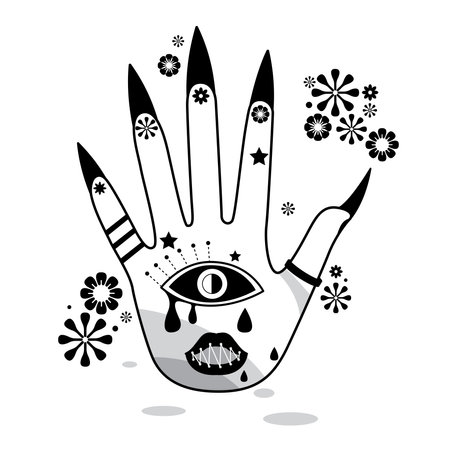Introduction to Palmistry and its Presence in British Traditions
Palmistry, also known as chiromancy, is the ancient art of interpreting the lines, shapes, and mounts of the hand to gain insights into an individual’s character and possible future. This practice, with roots stretching back thousands of years to India, China, and Egypt, eventually found fertile ground in Europe—and particularly in the United Kingdom. Over time, palmistry has become a familiar feature within British folklore and popular culture, often interwoven with local superstitions and storytelling traditions. From Romani fortune tellers at bustling Victorian fairs to subtle references in classic English literature, palmistry’s enduring allure reflects a uniquely British fascination with both mystery and self-discovery. The practice continues to intrigue modern Britons—whether as a parlour amusement or a serious tool for personal reflection—demonstrating how this age-old art remains relevant in contemporary society while retaining echoes of its historical significance.
2. Historical Influences: From Romany Caravans to Aristocratic Parlours
Palmistry’s journey in the UK is a fascinating tapestry woven from diverse cultural threads, stretching back centuries. The practice arrived on British shores via travelling communities, most notably the Romany people, whose caravans became synonymous with fortune-telling and palm readings in rural fairs and market towns. Their deep-rooted traditions carried echoes of ancient Indian and Middle Eastern wisdom, blending seamlessly with local folklore. Over time, palmistry began to intrigue not only the common folk but also the upper echelons of British society. During the Victorian era, it was embraced by fashionable parlours and drawing rooms, where curiosity about the mystical arts flourished alongside scientific advancement. The British aristocracy’s appetite for spiritualism and the esoteric transformed palmistry from a fringe practice into an intellectual pursuit and party entertainment. This cross-pollination between grassroots tradition and elite fascination laid the groundwork for palmistry’s enduring presence in modern British culture.
Key Phases in Palmistry’s Integration into British Society
| Period | Key Influences | Main Practitioners |
|---|---|---|
| Medieval Era | Folk beliefs, local superstitions | Village wise women, healers |
| 16th–18th Centuries | Romany migration, oral traditions | Travelling fortune-tellers |
| Victorian Period | Spiritualism, scientific curiosity | Aristocrats, society hostesses |
A Meeting Point of Tradition and Modernity
This evolution highlights how palmistry in the UK has always sat at a crossroads—drawing from both itinerant wisdom and high society’s quest for meaning. Today, its legacy is visible not just in summer fêtes or tourist hotspots but also in contemporary wellness circles and psychological self-exploration. The blend of Romany mystique and aristocratic endorsement continues to lend British palmistry its distinctive character—a fusion of folklore heritage and sophisticated intrigue.

3. Palmistry and British Superstition: Victorian Curiosity and Modern Cynicism
Britain’s relationship with the mystical has always been a tapestry of contradiction—woven from both credulity and scepticism. During the Victorian era, palmistry flourished amidst an unparalleled fascination with the occult, dovetailing with a society that revelled in séances, spiritualism, and scientific discovery alike. Palm readers became fixtures at fairs and parlour gatherings, their craft legitimised by a public eager for both amusement and answers to life’s enigmas. The Victorians, for all their rational innovations, were deeply enamoured with the unseen; palmistry thrived as a curiosity that danced on the boundary between entertainment and earnest belief.
Yet, this period of openness was always underpinned by an undercurrent of doubt. Satirical illustrations and biting commentaries frequently lampooned fortune tellers, positioning palmists as both mystical guides and convenient charlatans. This duality set the tone for how palmistry would be perceived in the UK for generations to come—a blend of intrigue tinged with suspicion.
Fast forward to modern Britain, and the cultural landscape has shifted dramatically. Today’s British public is often marked by a pragmatic cynicism, shaped by scientific advancement and a national penchant for irony. While palmistry retains its niche appeal—often reimagined as a quirky party trick or a nod to nostalgia—it is largely regarded with sceptical amusement rather than genuine conviction. However, there remains a quiet undercurrent of curiosity; contemporary Britons may outwardly dismiss palmistry but are not immune to its allure when confronted with their own palms at festivals or boutique markets.
This interplay between Victorian curiosity and modern cynicism encapsulates the enduring complexity of British attitudes towards palmistry. It is neither wholly dismissed nor fully embraced; instead, it occupies a unique cultural liminality—where superstition meets self-awareness, and tradition is continually renegotiated in light of modern values.
4. The Language of the Palm: British Terminology and Regional Variations
One of the most fascinating aspects of palmistry in the UK lies in its uniquely British lexicon and the subtle regional inflections that have shaped its practice over centuries. While the core tenets of palm reading remain broadly consistent worldwide, delving into how Britons talk about and interpret palmistry reveals a rich tapestry of idioms, dialectal quirks, and local superstitions.
Distinctively British Palmistry Terms
Palmists across Britain often employ homegrown terminology—sometimes with a wink to local humour or folklore. For instance, what many call the “Heart Line” elsewhere is frequently dubbed the “Lover’s Trace” in parts of England, reflecting a characteristically understated British approach to matters of romance. Similarly, some Scots refer to the “Fate Line” as the “Thread o’ Destiny,” echoing ancient Celtic beliefs about life’s predestined course.
Commonly Used Terms Across Regions
| Palmistry Term | Standard Name | British/Regional Variant |
|---|---|---|
| Heart Line | Heart Line | Lovers Trace (England), Life Vein (Wales) |
| Fate Line | Fate Line | Thread o’ Destiny (Scotland) |
| Mount of Venus | Mount of Venus | Cupid’s Hillock (Northern England) |
| Life Line | Life Line | The Long Walk (London Cockney slang) |
| Mercury Finger | Pinky/Little Finger | The Gossip (Southwest England) |
Idiomatic Expressions and Local Lore
The British penchant for idioms seeps into palmistry, too. Phrases like “to have fortune at one’s fingertips” or “crossed lines at tea time” are not uncommon during readings, subtly blending the mystical with everyday culture. In Yorkshire, there is an old saying: “A forked fate is a farmer’s lot,” referring to bifurcated Fate Lines commonly found among those working the land—hinting at hard choices and unpredictable outcomes.
Regional Twists in Interpretation
Beyond vocabulary, interpretation can also be coloured by local customs. A broad Mount of Luna might be seen as a sign of creativity in London but could be interpreted as a marker of second sight or intuition in rural Wales—a nod to lingering Celtic influences. In Scottish tradition, an unusually curved Heart Line may even spark whispers about fae connections or otherworldly ancestry.
Cultural Resonance Today
This tapestry of language and lore continues to enrich modern British palmistry. Whether heard in bustling London markets or remote Highland fairs, these linguistic twists offer more than novelty—they connect contemporary seekers with Britain’s layered history and evolving cultural landscape. Through these words and interpretations, palmistry remains both timeless and distinctly local.
5. Modern-Day Resonance: Palmistry in Contemporary British Society
In today’s Britain, palmistry has found a renewed sense of relevance, weaving itself into the fabric of modern culture in unexpected ways. While no longer confined to shadowy Victorian parlours or seaside fortune-telling booths, the art of chiromancy now enjoys visibility across multiple platforms—reflecting both continuity and transformation within British society.
The Media Spotlight: From Tabloids to Television
Palmistry’s enduring appeal is evident in its recurring presence throughout UK media. Tabloid newspapers occasionally feature palm-reading columns, while television programmes—ranging from light-hearted chat shows to investigative documentaries—explore the mysteries and social implications of the practice. Popular British soap operas and dramas have also portrayed palmists as quirky, often wise characters, reinforcing a sense of cultural familiarity and intrigue.
Pop Culture and Social Trends
British pop culture has long been fascinated by the mystical and the eccentric. In recent years, palmistry has been revitalised through festivals, lifestyle magazines, and even fashion trends that incorporate symbolic hand motifs. Social media influencers and content creators based in the UK regularly share insights about palm reading, blending tradition with contemporary self-expression. This digital democratisation allows palmistry to reach a younger audience eager for alternative forms of introspection.
Private Consultations: A Personal Touch
Despite its public presence, much of palmistry’s resonance lies in private practice. Across the UK, individuals seek out professional palmists for personal consultations—whether out of curiosity, hope for guidance, or simply the desire for a unique experience. The British approach tends to be characterised by a blend of open-minded scepticism and gentle humour; many clients approach readings with a “take it with a pinch of salt” attitude while still finding value in the reflective conversations sparked by these sessions.
The Uniquely British Perspective
What sets the British experience apart is a distinctive fusion of pragmatism and playfulness. Palmistry is often seen less as a strict predictor of fate and more as a tool for personal reflection—a catalyst for storytelling or self-discovery. In this way, it mirrors broader British attitudes towards spirituality: respectful but rarely dogmatic, curious yet grounded in everyday realities. The continued popularity of palmistry within contemporary society thus speaks to its adaptability and its subtle ability to reflect the evolving hopes, anxieties, and aspirations woven through modern British life.
6. Public Perceptions and Ongoing Debate in the UK
Palmistry’s place in contemporary British society is marked by a rich tapestry of opinions, ranging from outright scepticism to passionate belief. The modern dialogue around palm reading is reflective of broader cultural attitudes towards spirituality, alternative practices, and scientific rationalism. In this final section, we explore how palmistry is perceived by the British public, the ethical concerns it raises, and its evolving representation within public discourse.
Sceptics vs. Believers: A Cultural Crossroads
Within the UK, palmistry continues to polarise opinion. On one hand, sceptics—often guided by a strong tradition of empirical evidence and scientific thought—dismiss palm reading as pseudoscience or entertainment at best. They argue that any apparent accuracy in readings is the result of cold reading techniques or confirmation bias, rather than genuine insight into an individual’s fate or character.
The Enduring Appeal for Some
Yet, alongside this scepticism exists a thriving community of believers who find value in palmistry as a tool for self-reflection, personal growth, or simply as a time-honoured cultural practice. For many Britons, especially those interested in holistic wellness or alternative spiritualities, palm reading offers a sense of connection to history and an avenue for exploring life’s uncertainties outside conventional frameworks.
Ethical Debates: Responsibility and Respect
The practice of palmistry also sparks ongoing ethical debates in the UK. Critics raise concerns about exploitation or false hope—particularly when vulnerable individuals seek guidance during difficult times. Meanwhile, practitioners often emphasise responsibility and transparency, framing their work as entertainment or life coaching rather than absolute prophecy. Regulatory bodies and consumer protection organisations occasionally weigh in to ensure fair practice standards are upheld.
Palmistry in Public Discourse
Media representations of palmistry in Britain are varied: while some television programmes and newspapers treat it with tongue-in-cheek humour or curiosity, others delve more earnestly into its historical and psychological dimensions. Popular culture often reflects this duality—balancing fascination with folklore against modern sensibilities rooted in logic and evidence-based thinking.
Ultimately, the British conversation around palmistry remains dynamic—mirroring wider shifts in attitudes towards tradition, belief, and scientific inquiry. Whether regarded as superstition or self-discovery, palmistry continues to provoke debate and reflection across the UK’s diverse cultural landscape.


